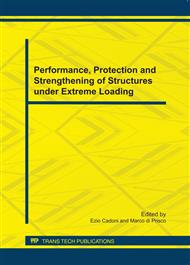p.392
p.398
p.404
p.410
p.416
p.422
p.428
p.434
p.440
Performance of Sacrificial Cladding Structure Made of Empty Recyclable Metal Beverage Cans under Large-Scale Air Blast Load
Abstract:
This paper demonstrates the use of recyclable waste products such as typical empty metal beverage cans available in the market for the protection of civil engineering structures from an explosive load. The sacrificial cladding structure was made of empty recyclable beverage cans and sandwich composite skin plates. To measure the protection efficiency of these structures large-scale air blast experiments have been conducted. To create a perfect plane shock wave the concept of shock tube was used using concrete sewage pipes. The experimental and numerical crushing performance of the empty beverage cans is studied in detail. Finally, this study concludes that the waste empty metal cans can be considered as a potential member to protect civil engineering structures from the air blast load.
Info:
Periodical:
Pages:
416-421
Citation:
Online since:
July 2011
Price:
Сopyright:
© 2011 Trans Tech Publications Ltd. All Rights Reserved
Share:
Citation:


